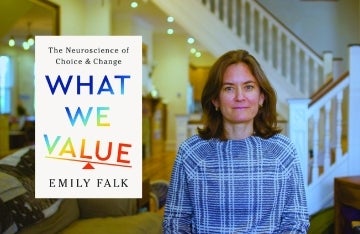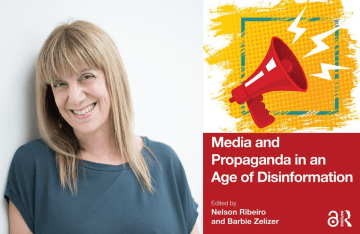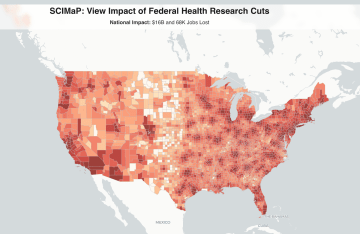Addressing the ‘Catch-22’ Academics Face on Social Media
The Center for Media at Risk and the Center on Digital Culture and Society brought together scholars to analyze the interconnected benefits and risks that academics face using social media.
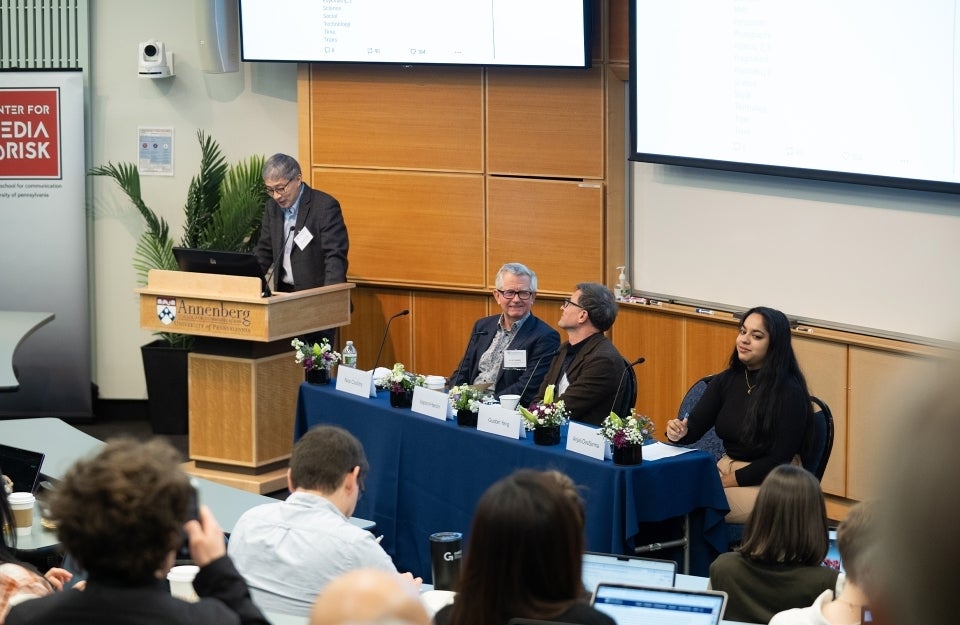
At the symposium “Academe in the Age of Social Media: Scholarly Inquiry at Risk?” Professor Guobin Yang, left, participated in a panel on the past and present of risks in academia associated with visibility and surveillance. Annenberg doctoral student Anjali DasSarma, right, moderated the panel. (Photo: Sharareh Faryadi)
A 2020 survey from Tampere University in Finland found that 30% of 2,492 academics reported facing online harassment in the past six months. A 2022 survey by researchers in Norway and Italy found that about half of the 162 respondents reported experiencing online harassment, while other research has found that female and minoritized scholars are the most likely targets of attacks. Professors may also feel concerned about their ability to maintain academic freedom among political and commercial pressures.
These issues can be particularly pertinent for communication and media scholars, who are both researching and using social media.
“We are dependent on social media, and if social media are constituting risks and intensifying danger for us by virtue of the very good things that we are trying to achieve—like public-facing scholarship, like building community—then we’re in a kind of catch-22,” says Barbie Zelizer, Raymond Williams Professor of Communication at the Annenberg School for Communication and director of the Center for Media at Risk.
Colleagues have experienced being trolled, harassed, and threatened but “probably have been treating this as our individual problems we have to manage,” says Guobin Yang, the Grace Lee Boggs Professor of Communication and Sociology at Annenberg and director of the Center on Digital Culture and Society. “In recent years, we’ve more and more begun to think about this as a collective issue, which would also require our collective effort to manage.”
Yang says they began having conversations in the spring or early summer about a two-day symposium on the topic “Academe in the Age of Social Media: Scholarly Inquiry at Risk?,” which their centers ended up hosting at Penn in December. Zelizer says the issue became more critical in the interim, with the ongoing pressure put on universities around pro-Palestine protests constituting a “dress rehearsal for what might come next” with Donald Trump’s presidency.
“What might have been—last summer, when we began—a possible risk in the future became a certain probability,” Zelizer says. “I don’t think anybody’s assuming that the universities are going to be left alone.”
The Center for Media at Risk holds a symposium every December “around some issue that’s in need of nurturing, in need of care, in need of clarification,” Zelizer says. While she and Yang—who both caught up with Penn Today after this year’s symposium—came up with the topic, graduate students organized the event and formulated questions for the panels, which left a lot of time for audience questions.
The planning committee included Annenberg doctoral students Anjali DasSarma, Natasha Williams, Valentina Proust, Jenny Lee, and Liz Hallgren. They moderated panels on the past and present of risks to academia associated with visibility and surveillance, the fine line between opportunity and risk, and the role of social media in amplifying marginalized voices and fostering activism. Yang says one question discussed a lot was how institutions could support academics facing attacks, which are often anonymous.
The keynote speakers were Todd Wolfson, national president of the American Association of University Professors and Co-Director of the Media Inequality & Change Center, a collaboration between Annenberg and Rutgers University, who spoke about unionizing, and Rebekah Tromble, associate professor at the George Washington University and director of its Institute for Data, Democracy, and Politics.
“They were remarkable because they offered equal amounts of practical solutions and practical tips for what to do moving forward as well as intellectual discussion of why this matters,” Zelizer says.
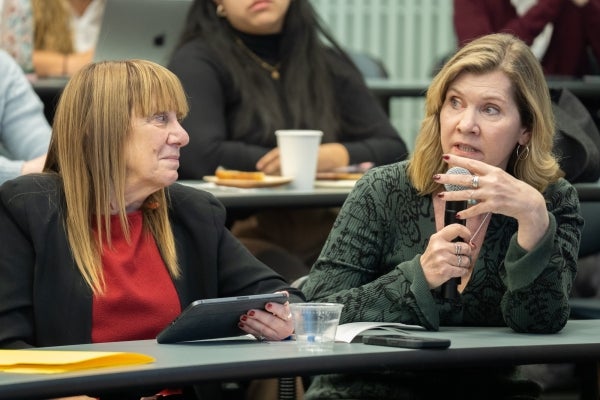
Tromble co-created the Researcher Support Consortium, which launched in September, to support colleagues “who have faced coordinated campaigns of intimidation and harassment in response to their important public-facing work.” She told Inside Higher Ed that she received death threats and rape threats for participating in research on Twitter discourse, resulting in the need to move her office and have police patrols outside her home.
Another instance of an academic receiving threats from social media activity was making headlines leading up to the symposium. Literary scholar Ally Louks had posted on X a picture of her holding her thesis, “Olfactory Ethics: The Politics of Smell in Modern Prose,” with the caption, “Thrilled to say I passed my viva with no corrections and am officially PhDone.” The response shifted from congratulatory messages to right-wing attacks that the topic was too “woke,” misogyny, and broader criticisms of higher education, with the post receiving more than 120 million views.
“You never know who is among the audience. You put something out there and you don’t know who is monitoring or following or scrutinizing,” Yang says.
Zelizer says social media posts can become one-way chambers without the opportunity for exchange, and that’s not what she means or wants when she talks about public-facing scholarship. She says the measure of public-facing scholarship should not be about the number of views or likes a post gets but “about the sustained connections that ensue afterwards.” But there is no way to track or understand that.
“I don’t think that we’ve spoken much in the academy about what this is doing to the identity of professors and what this is doing to the prospects of doctoral students, what this is doing to the precarious parts of the academy,” Zelizer says. Yang says the gathering opened a lot of discussion about both problems and possibilities for the future, and “I think people left the conference feeling energized and hopeful.”

